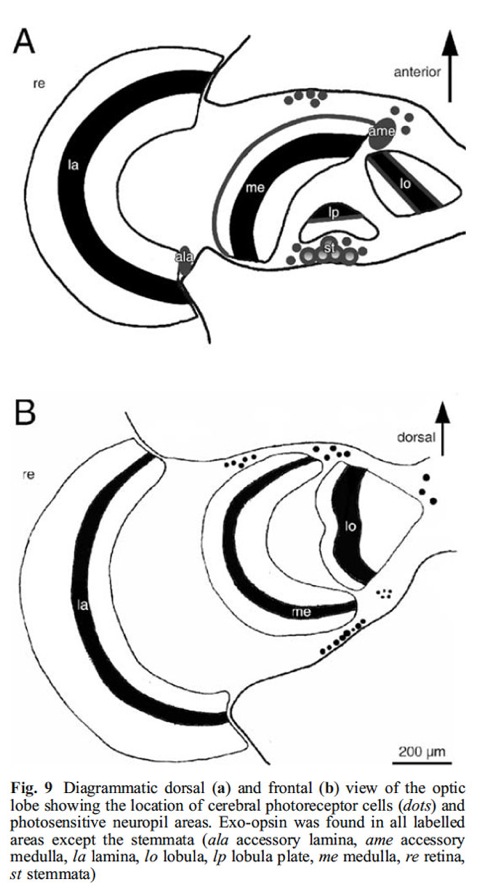Lampel, J., Briscoe A.D. & Wasserthal, L.T. (2005): Expression of UV-, blue, long wavelength-sensitive opsins and melatonin in extraretinal photoreceptors of the optic lobes of hawkmoths. Cell and Tissue Research 321. 443-458.
Lepidopterans display biological rhythms associated with egg laying, eclosion and flight activity but the photoreceptors that mediate these behavioural patterns are largely unknown. To further our progress in identifying candidate light-input channels for the lepidopteran circadian system, we have developed polyclonal antibodies against ultraviolet (UV)-, blue- and extraretinal long-wavelength (LW)-sensitive opsins and examined opsin immunoreactivity in the adult optic lobes of four hawk moths, Manduca sexta, Acherontia atropos, Agrius convolvuli and Hippotion celerio. Outside the retina, UV and blue opsin protein expression is restricted to the adult stemmata, with no apparent expression elsewhere in the brain. Melatonin, which is known to have a seasonal influence on reproduction and behaviour, is expressed with opsins in adult stemmata together with visual arrestin and chaoptin. By contrast, the LW opsin protein is not expressed in the retina or stemmata but rather exhibits a distinct and widespread distribution in dorsal and ventral neurons of the optic lobes. The lamina, medulla, lobula and lobula plate, accessory medulla and adjacent neurons innervating this structure also exhibit strong LW opsin immunoreactivity. Together with the adult stemmata, these neurons appear to be functional photoreceptors, as visual arrestin, chaoptin and melatonin are also co-expressed with LW opsin. These findings are the first to suggest a role for three spectrally distinct classes of opsin in the extraretinal detection of changes in ambient light and to show melatonin-mediated neuroendocrine output in the entrainment of sphingid moth circadian and/or photoperiodic rhythms.

